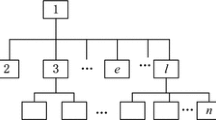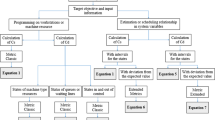Abstract
To solve the problem that it is short of quantitative ways, when the project of structural optimization on production system is evaluated and entropic model exists in the present study of systemic order degree, aging–quality entropy model with operable characteristic are developed based on an information-entropic approach. In an empirical study, taking typical parts in a job shop as object, the paper analyzes these parts go through the different production structure on the same process routing before and after the job shop is actualized cellular manufacturing. Furthermore, the order degree under the two different conditions is finally calculated by using the models of aging–quality entropy and order degree. As a result, this quantitative way of evaluating the orderliness of production structure is validated well and extends application area of this entropic model.



Similar content being viewed by others
References
Kyamakya K (2000) Survivability performance analysis of rerouting strategy in a planning. Transport Sci 34(2):165–179. doi:10.1287/trsc.34.2.165.12303
Chueh CH (2004) An immune algorithm for engineering optimization. Tatung University, Taiwan
Schmitt LM (2004) Theory of genetic algorithms. Theor Comput Sci 3100(2):181–231. doi:10.1016/S0304-3975(03)00393-1
Alisantoso D, Khoo LP, Jiang PY (2003) An immune algorithm approach to the scheduling of a Flexible PCB flow shop. Adv Manuf Technol 22:819–827. doi:10.1007/s00170-002-1498-5
Kumar R, Tiwari MK (2003) Scheduling of flexible manufacturing systems: an ant colony optimization approach. Proc Inst Mech Eng Part B J Eng Manuf 217(10):1443–1453
Wiley EO, Layzer D (1988) Information in cosmology, physics and biology. Quantum Chem 12(1):185–195
Frizelle G (1998) The management of complexity in manufacturing. Business Intelligence Ltd., London, UK
Checkland P (2003) Systems thinking, systems practice. Wiley, Chichester
Dretske FI (1999) Knowledge and the flow of information. the David Hume Series, Philosophy and cognitive science reissues. CSLI Publications, San Francisco
Efstathiou J, Tassano F, Sivadasan S et al (1999) Information complexity as a driver of emergent phenomena in the business community invited paper. In: Proceedings of the international workshop on emergent synthesis. Kobe University, Japan, vol 12, pp 1–6
Liu S, Qiu W (1997) A generalized risk-return model for project selection. J Syst Sci Syst Eng 6(4):385–388
Ronen B, Karp A (2003) An information entropy approach to the small-lot concept. IEEE Trans Eng Manage 41(1):88–92
Smith SA (1974) A derivational of entropy and the maximum entropy criterion in the context of decision problems. IEEE Trans Syst Man Cybern SSC-4:157–168
Heragu SS, Kakututi SR (1997) Grouping and Placement of Machine Cells. IIE Trans (29):561–571
Theodor IF (2003) Reliability and productivity of reconfigurable manufacturing system. PhD, University of Michigan
Li JR, Khoo LP, Top SB (2003) A tabu-enhanced genetic algorithm approach for assemble process planning. J Intell Manuf 14:197–208. doi:10.1023/A:1022903514179
Heizer J, Render B (2001) Operations Management. Prentice-Hall, Inc., USA
Acknowledgments
This work is supported by the National Natural Science Foundation of China under the Grant No. 60474077.
Author information
Authors and Affiliations
Corresponding author
Rights and permissions
About this article
Cite this article
Zhang, Z., Wang, Z. Empirical study on orderliness evaluation of production system based on aging–quality entropy. Prod. Eng. Res. Devel. 3, 95–101 (2009). https://doi.org/10.1007/s11740-008-0129-x
Received:
Accepted:
Published:
Issue Date:
DOI: https://doi.org/10.1007/s11740-008-0129-x




